Xiaohui Zeng
DreamGen: Unlocking Generalization in Robot Learning through Neural Trajectories
May 19, 2025Abstract:We introduce DreamGen, a simple yet highly effective 4-stage pipeline for training robot policies that generalize across behaviors and environments through neural trajectories - synthetic robot data generated from video world models. DreamGen leverages state-of-the-art image-to-video generative models, adapting them to the target robot embodiment to produce photorealistic synthetic videos of familiar or novel tasks in diverse environments. Since these models generate only videos, we recover pseudo-action sequences using either a latent action model or an inverse-dynamics model (IDM). Despite its simplicity, DreamGen unlocks strong behavior and environment generalization: a humanoid robot can perform 22 new behaviors in both seen and unseen environments, while requiring teleoperation data from only a single pick-and-place task in one environment. To evaluate the pipeline systematically, we introduce DreamGen Bench, a video generation benchmark that shows a strong correlation between benchmark performance and downstream policy success. Our work establishes a promising new axis for scaling robot learning well beyond manual data collection.
VideoPanda: Video Panoramic Diffusion with Multi-view Attention
Apr 15, 2025Abstract:High resolution panoramic video content is paramount for immersive experiences in Virtual Reality, but is non-trivial to collect as it requires specialized equipment and intricate camera setups. In this work, we introduce VideoPanda, a novel approach for synthesizing 360$^\circ$ videos conditioned on text or single-view video data. VideoPanda leverages multi-view attention layers to augment a video diffusion model, enabling it to generate consistent multi-view videos that can be combined into immersive panoramic content. VideoPanda is trained jointly using two conditions: text-only and single-view video, and supports autoregressive generation of long-videos. To overcome the computational burden of multi-view video generation, we randomly subsample the duration and camera views used during training and show that the model is able to gracefully generalize to generating more frames during inference. Extensive evaluations on both real-world and synthetic video datasets demonstrate that VideoPanda generates more realistic and coherent 360$^\circ$ panoramas across all input conditions compared to existing methods. Visit the project website at https://research-staging.nvidia.com/labs/toronto-ai/VideoPanda/ for results.
Cosmos-Transfer1: Conditional World Generation with Adaptive Multimodal Control
Mar 18, 2025Abstract:We introduce Cosmos-Transfer, a conditional world generation model that can generate world simulations based on multiple spatial control inputs of various modalities such as segmentation, depth, and edge. In the design, the spatial conditional scheme is adaptive and customizable. It allows weighting different conditional inputs differently at different spatial locations. This enables highly controllable world generation and finds use in various world-to-world transfer use cases, including Sim2Real. We conduct extensive evaluations to analyze the proposed model and demonstrate its applications for Physical AI, including robotics Sim2Real and autonomous vehicle data enrichment. We further demonstrate an inference scaling strategy to achieve real-time world generation with an NVIDIA GB200 NVL72 rack. To help accelerate research development in the field, we open-source our models and code at https://github.com/nvidia-cosmos/cosmos-transfer1.
Cosmos-Reason1: From Physical Common Sense To Embodied Reasoning
Mar 18, 2025Abstract:Physical AI systems need to perceive, understand, and perform complex actions in the physical world. In this paper, we present the Cosmos-Reason1 models that can understand the physical world and generate appropriate embodied decisions (e.g., next step action) in natural language through long chain-of-thought reasoning processes. We begin by defining key capabilities for Physical AI reasoning, with a focus on physical common sense and embodied reasoning. To represent physical common sense, we use a hierarchical ontology that captures fundamental knowledge about space, time, and physics. For embodied reasoning, we rely on a two-dimensional ontology that generalizes across different physical embodiments. Building on these capabilities, we develop two multimodal large language models, Cosmos-Reason1-8B and Cosmos-Reason1-56B. We curate data and train our models in four stages: vision pre-training, general supervised fine-tuning (SFT), Physical AI SFT, and Physical AI reinforcement learning (RL) as the post-training. To evaluate our models, we build comprehensive benchmarks for physical common sense and embodied reasoning according to our ontologies. Evaluation results show that Physical AI SFT and reinforcement learning bring significant improvements. To facilitate the development of Physical AI, we will make our code and pre-trained models available under the NVIDIA Open Model License at https://github.com/nvidia-cosmos/cosmos-reason1.
Not-So-Optimal Transport Flows for 3D Point Cloud Generation
Feb 18, 2025Abstract:Learning generative models of 3D point clouds is one of the fundamental problems in 3D generative learning. One of the key properties of point clouds is their permutation invariance, i.e., changing the order of points in a point cloud does not change the shape they represent. In this paper, we analyze the recently proposed equivariant OT flows that learn permutation invariant generative models for point-based molecular data and we show that these models scale poorly on large point clouds. Also, we observe learning (equivariant) OT flows is generally challenging since straightening flow trajectories makes the learned flow model complex at the beginning of the trajectory. To remedy these, we propose not-so-optimal transport flow models that obtain an approximate OT by an offline OT precomputation, enabling an efficient construction of OT pairs for training. During training, we can additionally construct a hybrid coupling by combining our approximate OT and independent coupling to make the target flow models easier to learn. In an extensive empirical study, we show that our proposed model outperforms prior diffusion- and flow-based approaches on a wide range of unconditional generation and shape completion on the ShapeNet benchmark.
Cosmos World Foundation Model Platform for Physical AI
Jan 07, 2025



Abstract:Physical AI needs to be trained digitally first. It needs a digital twin of itself, the policy model, and a digital twin of the world, the world model. In this paper, we present the Cosmos World Foundation Model Platform to help developers build customized world models for their Physical AI setups. We position a world foundation model as a general-purpose world model that can be fine-tuned into customized world models for downstream applications. Our platform covers a video curation pipeline, pre-trained world foundation models, examples of post-training of pre-trained world foundation models, and video tokenizers. To help Physical AI builders solve the most critical problems of our society, we make our platform open-source and our models open-weight with permissive licenses available via https://github.com/NVIDIA/Cosmos.
LLaMA-Mesh: Unifying 3D Mesh Generation with Language Models
Nov 14, 2024



Abstract:This work explores expanding the capabilities of large language models (LLMs) pretrained on text to generate 3D meshes within a unified model. This offers key advantages of (1) leveraging spatial knowledge already embedded in LLMs, derived from textual sources like 3D tutorials, and (2) enabling conversational 3D generation and mesh understanding. A primary challenge is effectively tokenizing 3D mesh data into discrete tokens that LLMs can process seamlessly. To address this, we introduce LLaMA-Mesh, a novel approach that represents the vertex coordinates and face definitions of 3D meshes as plain text, allowing direct integration with LLMs without expanding the vocabulary. We construct a supervised fine-tuning (SFT) dataset enabling pretrained LLMs to (1) generate 3D meshes from text prompts, (2) produce interleaved text and 3D mesh outputs as required, and (3) understand and interpret 3D meshes. Our work is the first to demonstrate that LLMs can be fine-tuned to acquire complex spatial knowledge for 3D mesh generation in a text-based format, effectively unifying the 3D and text modalities. LLaMA-Mesh achieves mesh generation quality on par with models trained from scratch while maintaining strong text generation performance.
Edify 3D: Scalable High-Quality 3D Asset Generation
Nov 11, 2024
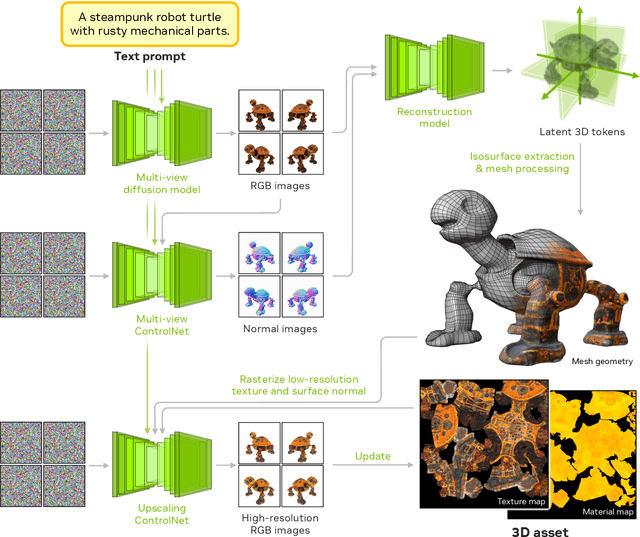
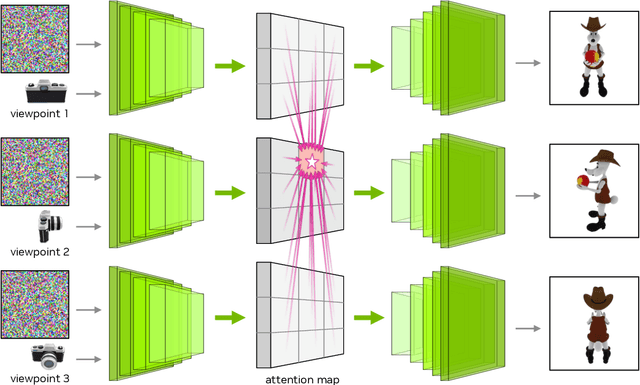
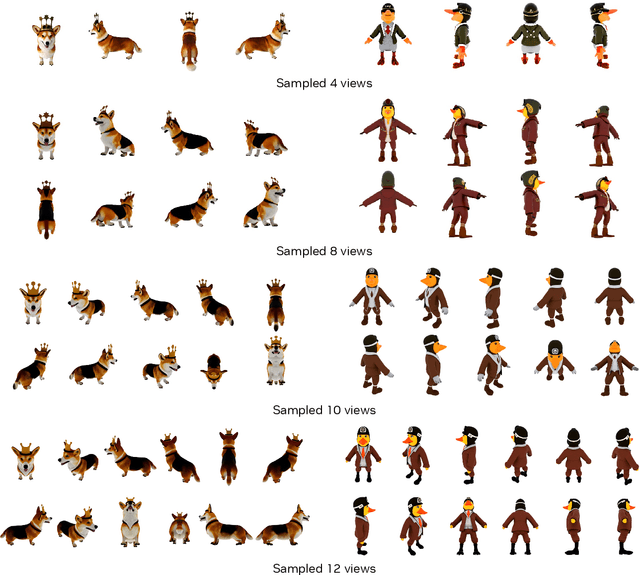
Abstract:We introduce Edify 3D, an advanced solution designed for high-quality 3D asset generation. Our method first synthesizes RGB and surface normal images of the described object at multiple viewpoints using a diffusion model. The multi-view observations are then used to reconstruct the shape, texture, and PBR materials of the object. Our method can generate high-quality 3D assets with detailed geometry, clean shape topologies, high-resolution textures, and materials within 2 minutes of runtime.
Edify Image: High-Quality Image Generation with Pixel Space Laplacian Diffusion Models
Nov 11, 2024Abstract:We introduce Edify Image, a family of diffusion models capable of generating photorealistic image content with pixel-perfect accuracy. Edify Image utilizes cascaded pixel-space diffusion models trained using a novel Laplacian diffusion process, in which image signals at different frequency bands are attenuated at varying rates. Edify Image supports a wide range of applications, including text-to-image synthesis, 4K upsampling, ControlNets, 360 HDR panorama generation, and finetuning for image customization.
Fréchet Video Motion Distance: A Metric for Evaluating Motion Consistency in Videos
Jul 23, 2024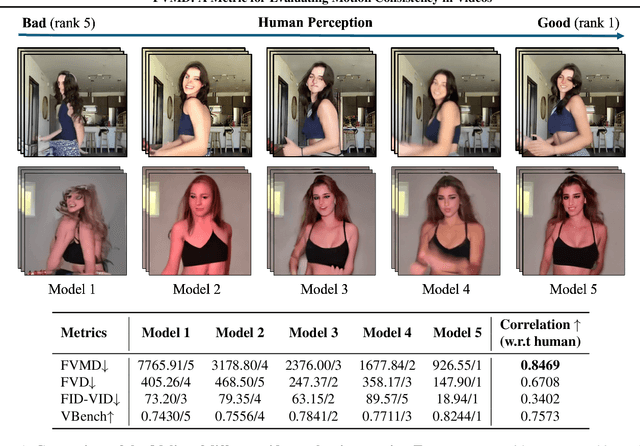
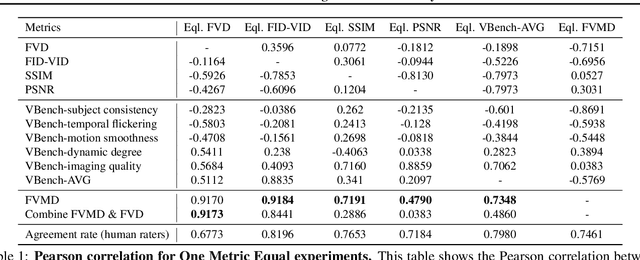


Abstract:Significant advancements have been made in video generative models recently. Unlike image generation, video generation presents greater challenges, requiring not only generating high-quality frames but also ensuring temporal consistency across these frames. Despite the impressive progress, research on metrics for evaluating the quality of generated videos, especially concerning temporal and motion consistency, remains underexplored. To bridge this research gap, we propose Fr\'echet Video Motion Distance (FVMD) metric, which focuses on evaluating motion consistency in video generation. Specifically, we design explicit motion features based on key point tracking, and then measure the similarity between these features via the Fr\'echet distance. We conduct sensitivity analysis by injecting noise into real videos to verify the effectiveness of FVMD. Further, we carry out a large-scale human study, demonstrating that our metric effectively detects temporal noise and aligns better with human perceptions of generated video quality than existing metrics. Additionally, our motion features can consistently improve the performance of Video Quality Assessment (VQA) models, indicating that our approach is also applicable to unary video quality evaluation. Code is available at https://github.com/ljh0v0/FMD-frechet-motion-distance.
 Add to Chrome
Add to Chrome Add to Firefox
Add to Firefox Add to Edge
Add to Edge